Ensuring rights of ethnic minorities in India and policy implications for Vietnam
India is a country with diverse ethnic groups. To ensure special rights and benefits for
ethnic minority groups, the Indian Government has regulations on preferential treatment in terms
of policies, capital provision, education and employment opportunities included in its
Constitution. In addition to providing legal protection to minorities in the Constitution, the
Government also implements national projects to promote socio-economic development in ethnic
minority areas, establishing various agencies to manage issues of the groups. These are useful
recommendations for Vietnam in ensuring the rights of ethnic minorities.
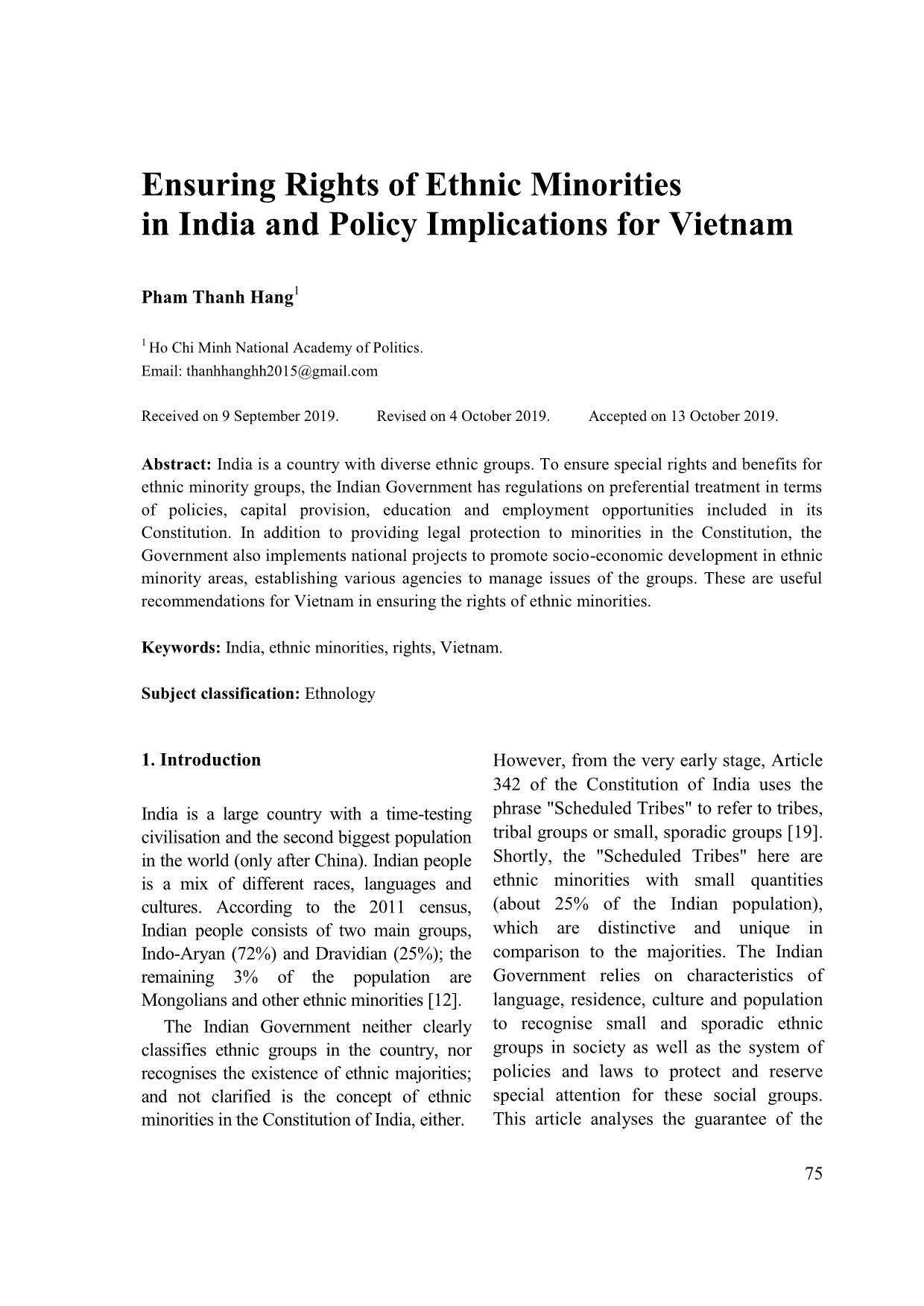
Trang 1
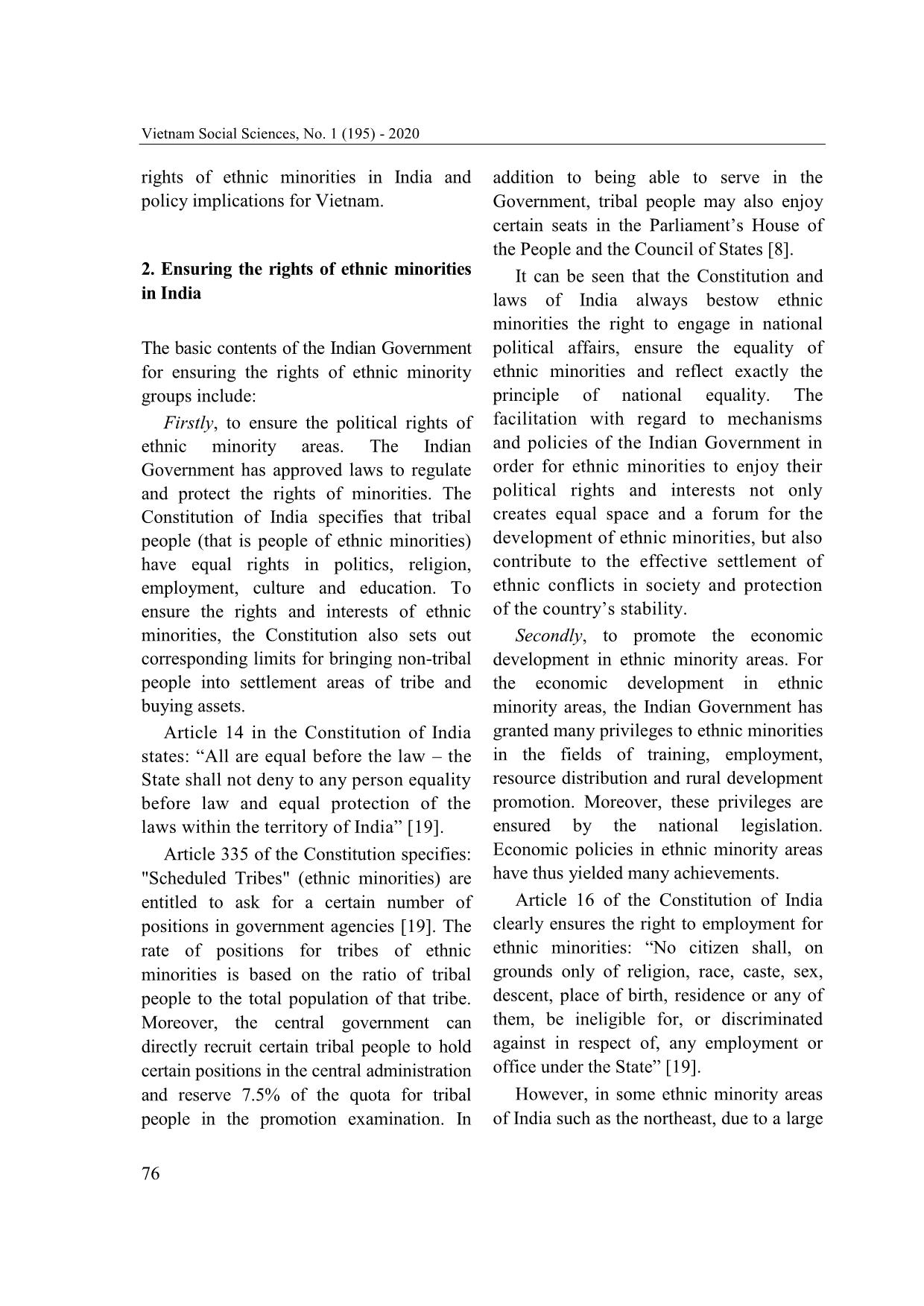
Trang 2
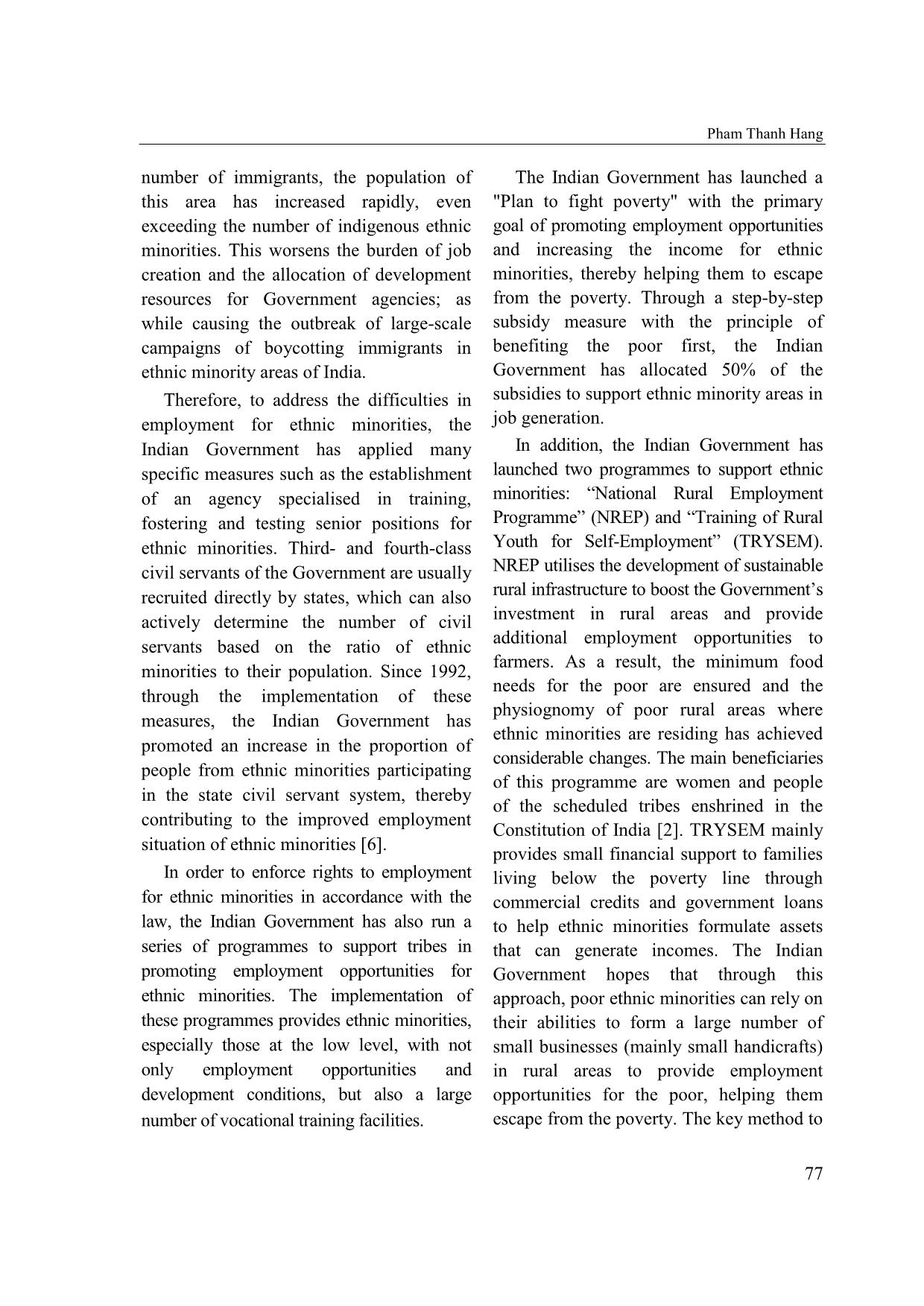
Trang 3
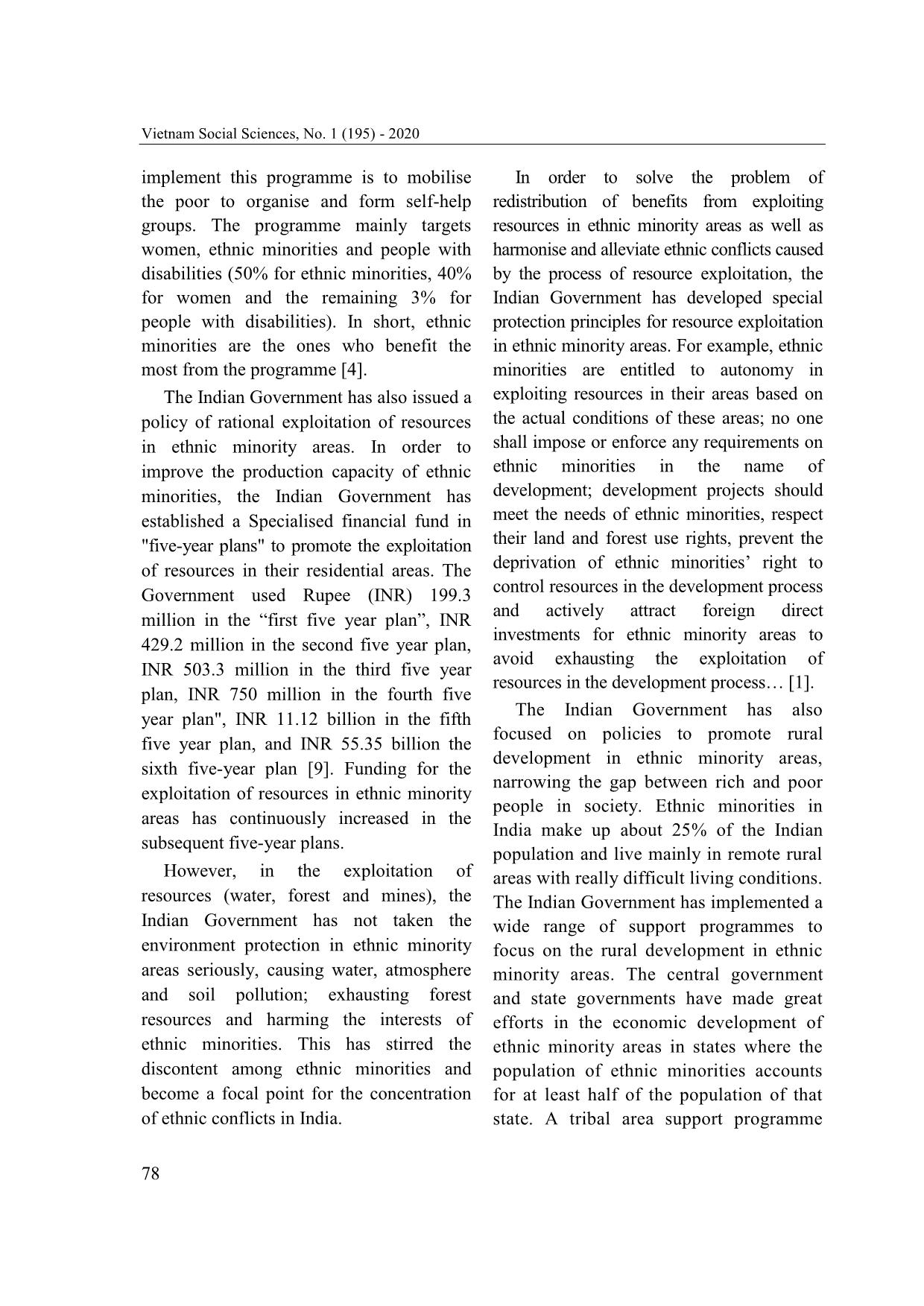
Trang 4
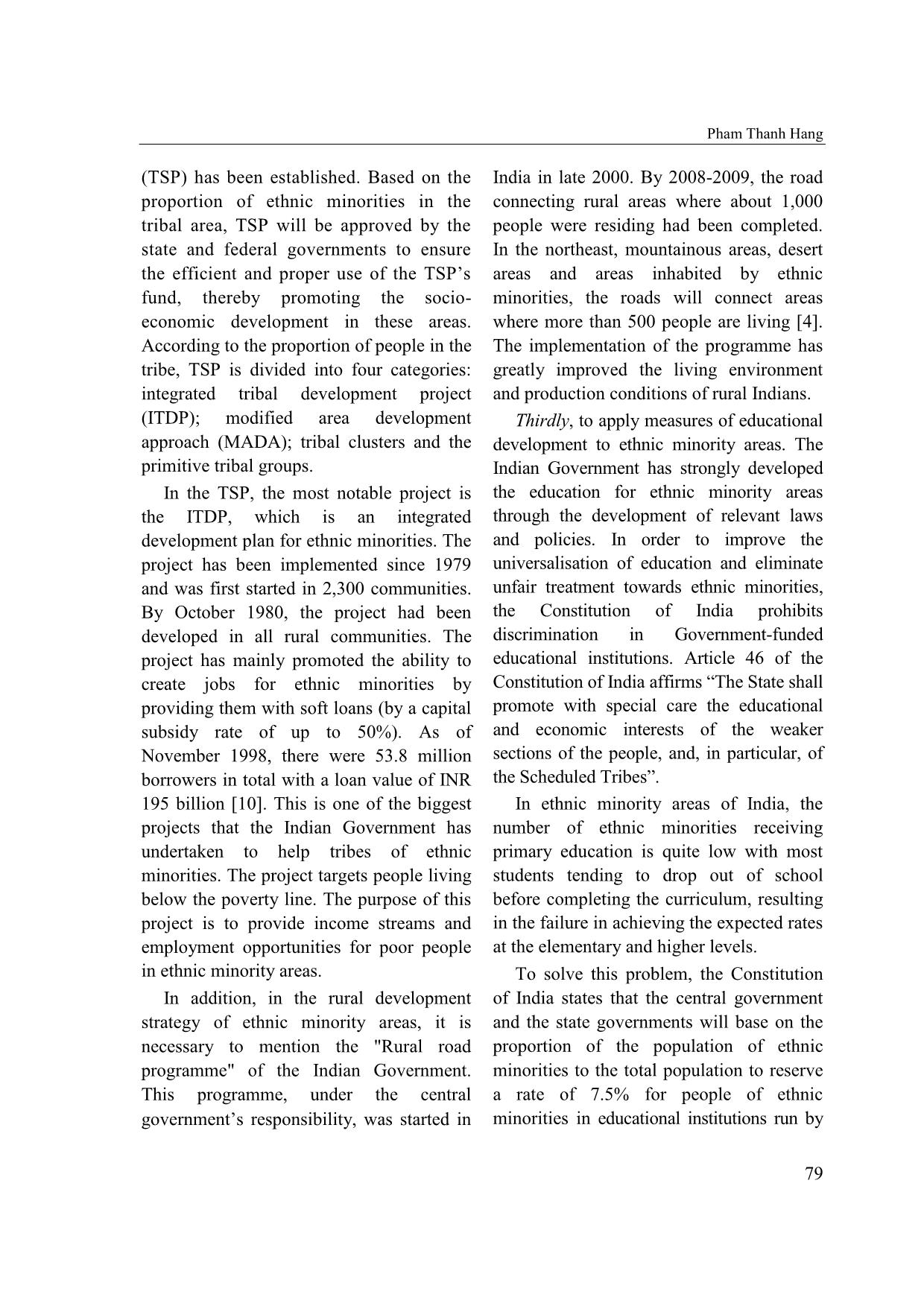
Trang 5
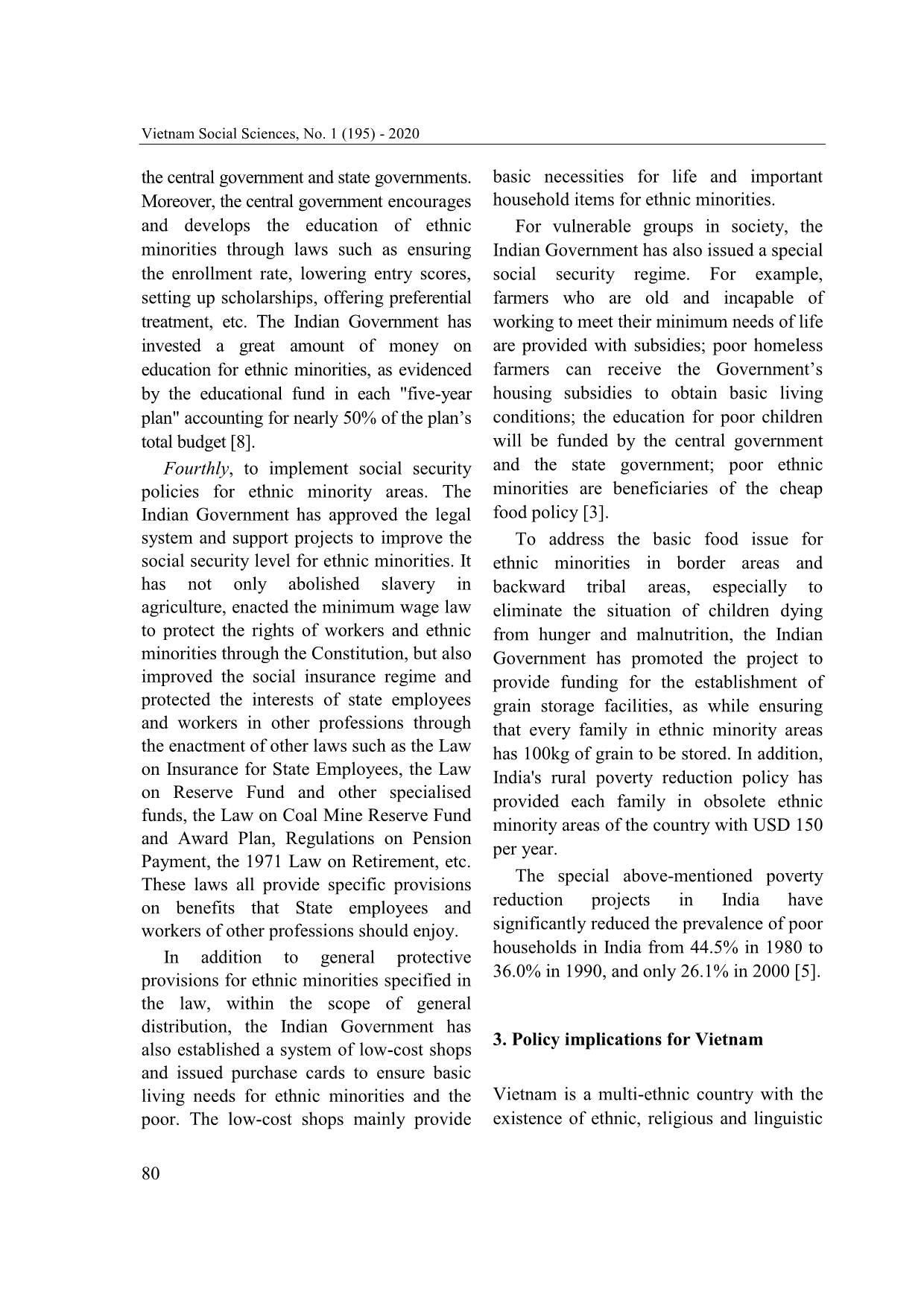
Trang 6
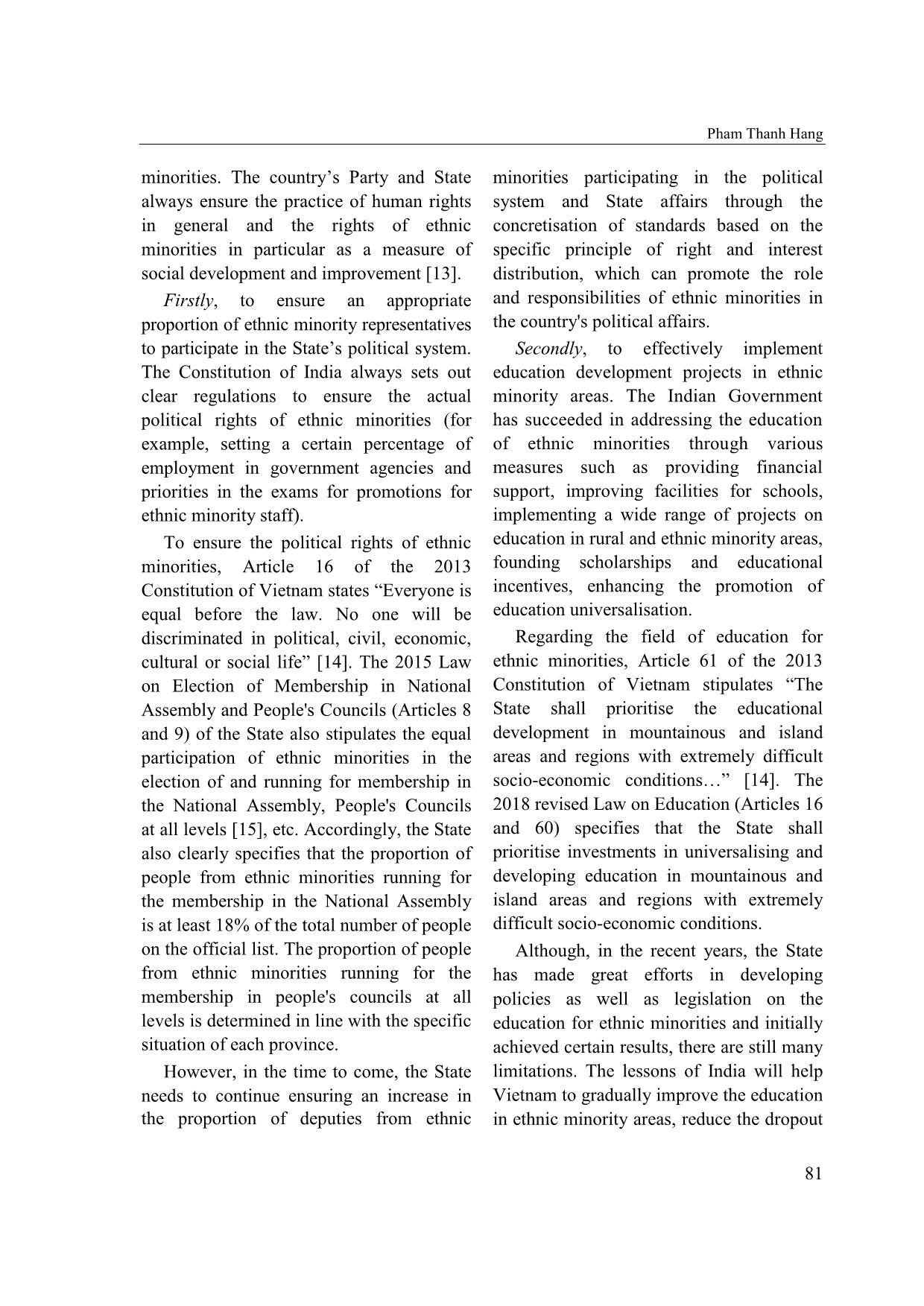
Trang 7
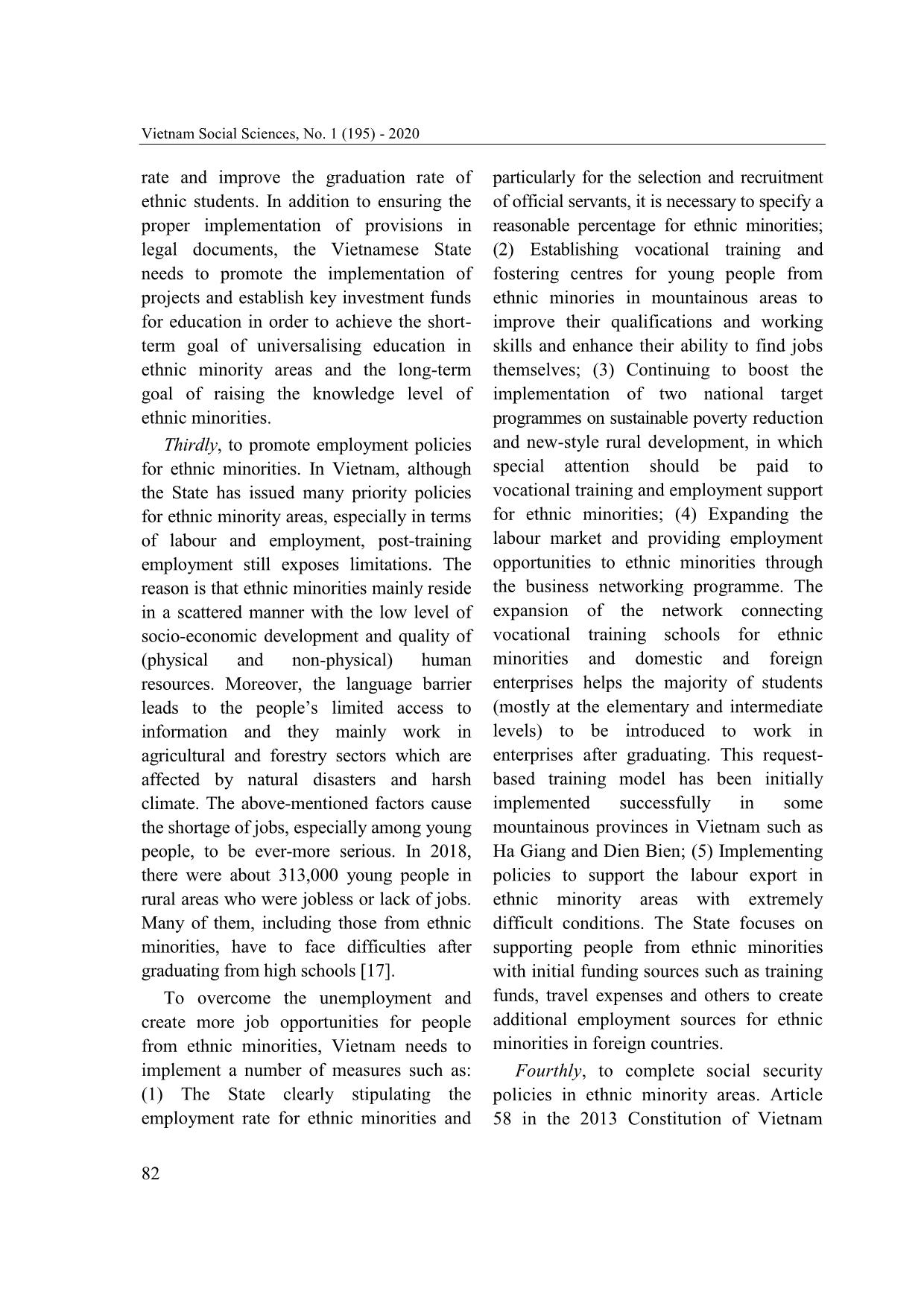
Trang 8
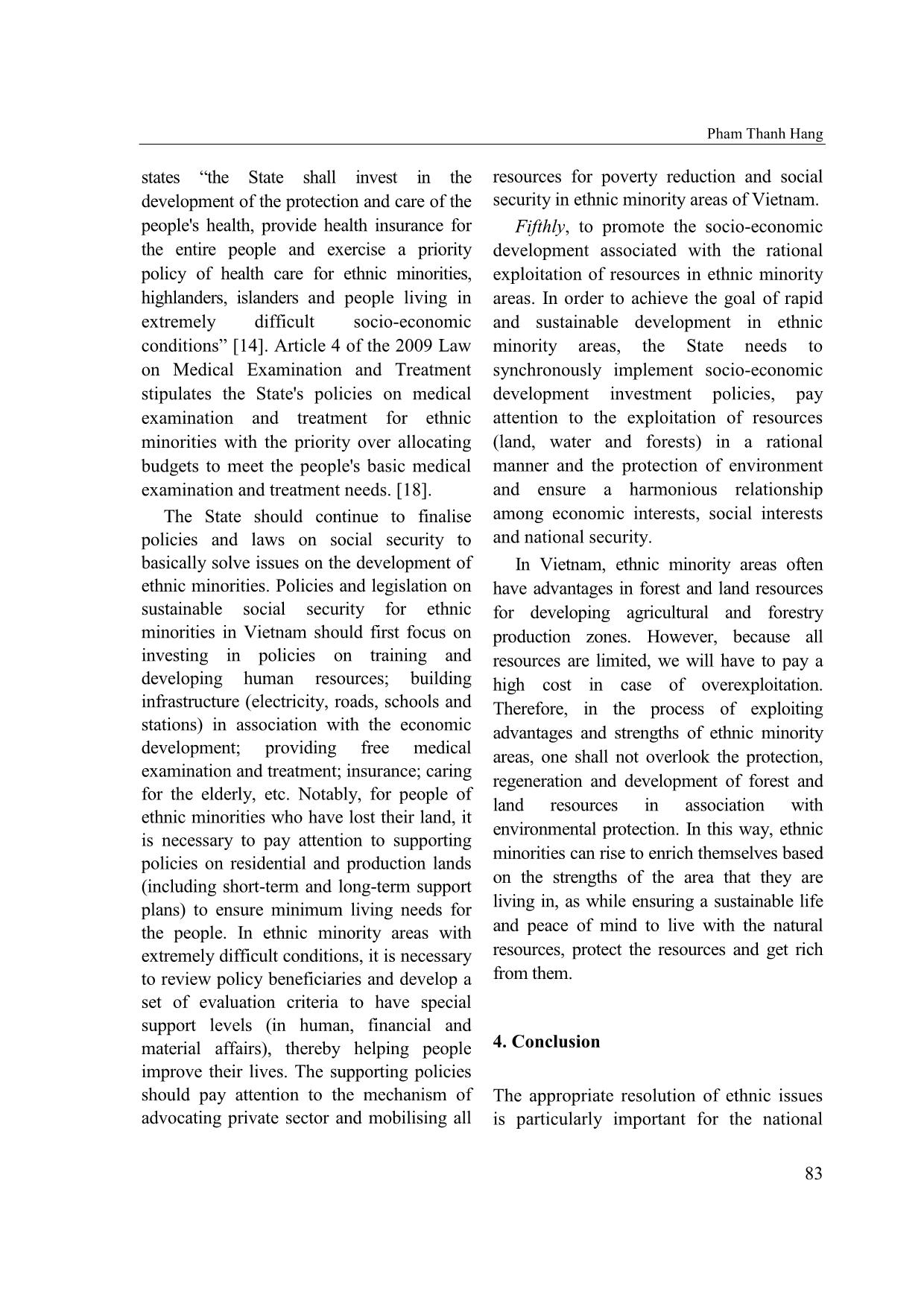
Trang 9
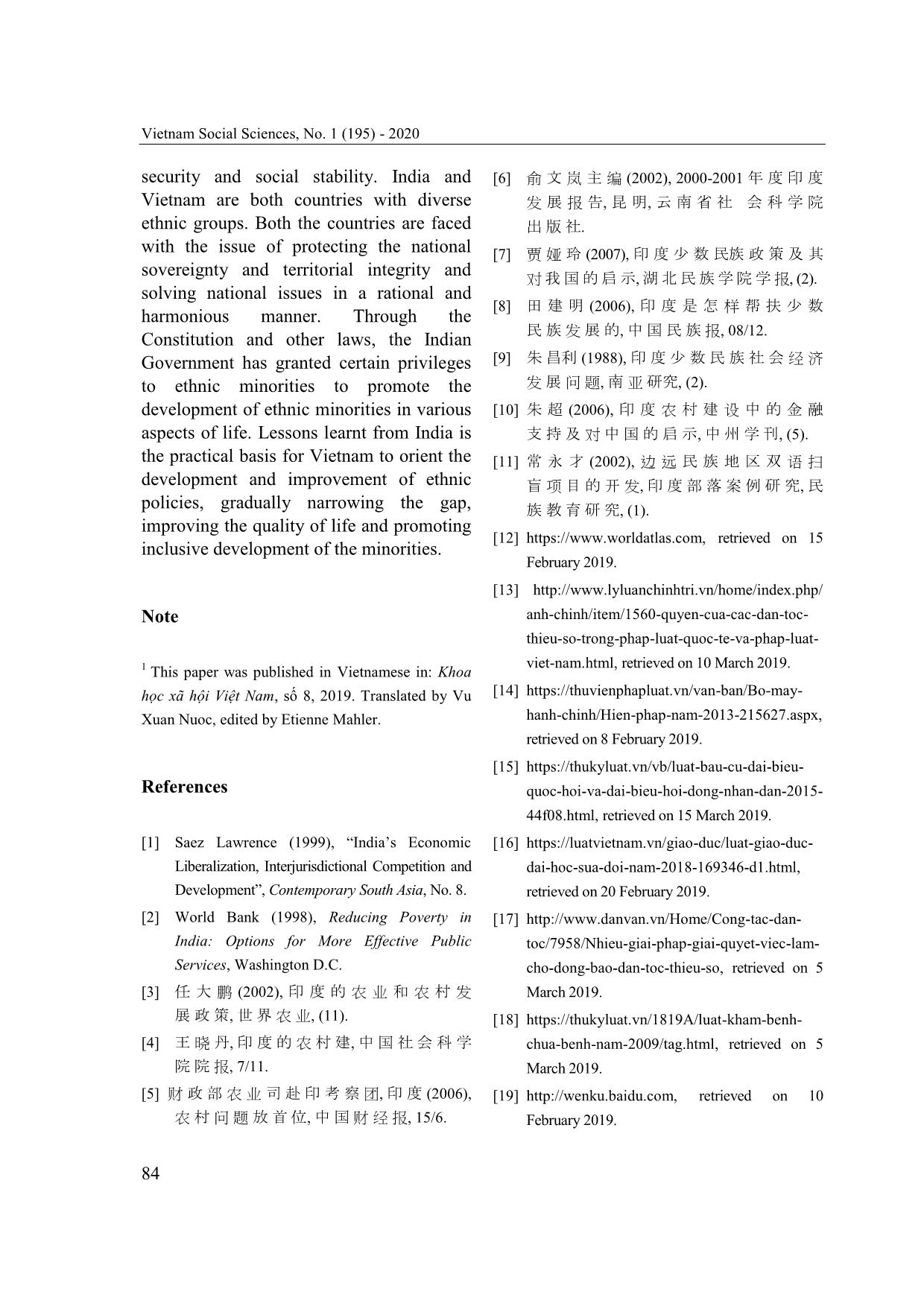
Trang 10
Bạn đang xem tài liệu "Ensuring rights of ethnic minorities in India and policy implications for Vietnam", để tải tài liệu gốc về máy hãy click vào nút Download ở trên
Tóm tắt nội dung tài liệu: Ensuring rights of ethnic minorities in India and policy implications for Vietnam
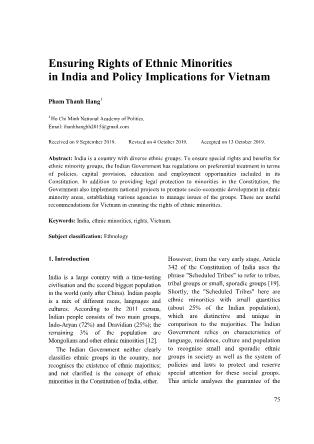
ific provisions on benefits that State employees and workers of other professions should enjoy. In addition to general protective provisions for ethnic minorities specified in the law, within the scope of general distribution, the Indian Government has also established a system of low-cost shops and issued purchase cards to ensure basic living needs for ethnic minorities and the poor. The low-cost shops mainly provide basic necessities for life and important household items for ethnic minorities. For vulnerable groups in society, the Indian Government has also issued a special social security regime. For example, farmers who are old and incapable of working to meet their minimum needs of life are provided with subsidies; poor homeless farmers can receive the Government’s housing subsidies to obtain basic living conditions; the education for poor children will be funded by the central government and the state government; poor ethnic minorities are beneficiaries of the cheap food policy [3]. To address the basic food issue for ethnic minorities in border areas and backward tribal areas, especially to eliminate the situation of children dying from hunger and malnutrition, the Indian Government has promoted the project to provide funding for the establishment of grain storage facilities, as while ensuring that every family in ethnic minority areas has 100kg of grain to be stored. In addition, India's rural poverty reduction policy has provided each family in obsolete ethnic minority areas of the country with USD 150 per year. The special above-mentioned poverty reduction projects in India have significantly reduced the prevalence of poor households in India from 44.5% in 1980 to 36.0% in 1990, and only 26.1% in 2000 [5]. 3. Policy implications for Vietnam Vietnam is a multi-ethnic country with the existence of ethnic, religious and linguistic Pham Thanh Hang 81 minorities. The country’s Party and State always ensure the practice of human rights in general and the rights of ethnic minorities in particular as a measure of social development and improvement [13]. Firstly, to ensure an appropriate proportion of ethnic minority representatives to participate in the State’s political system. The Constitution of India always sets out clear regulations to ensure the actual political rights of ethnic minorities (for example, setting a certain percentage of employment in government agencies and priorities in the exams for promotions for ethnic minority staff). To ensure the political rights of ethnic minorities, Article 16 of the 2013 Constitution of Vietnam states “Everyone is equal before the law. No one will be discriminated in political, civil, economic, cultural or social life” [14]. The 2015 Law on Election of Membership in National Assembly and People's Councils (Articles 8 and 9) of the State also stipulates the equal participation of ethnic minorities in the election of and running for membership in the National Assembly, People's Councils at all levels [15], etc. Accordingly, the State also clearly specifies that the proportion of people from ethnic minorities running for the membership in the National Assembly is at least 18% of the total number of people on the official list. The proportion of people from ethnic minorities running for the membership in people's councils at all levels is determined in line with the specific situation of each province. However, in the time to come, the State needs to continue ensuring an increase in the proportion of deputies from ethnic minorities participating in the political system and State affairs through the concretisation of standards based on the specific principle of right and interest distribution, which can promote the role and responsibilities of ethnic minorities in the country's political affairs. Secondly, to effectively implement education development projects in ethnic minority areas. The Indian Government has succeeded in addressing the education of ethnic minorities through various measures such as providing financial support, improving facilities for schools, implementing a wide range of projects on education in rural and ethnic minority areas, founding scholarships and educational incentives, enhancing the promotion of education universalisation. Regarding the field of education for ethnic minorities, Article 61 of the 2013 Constitution of Vietnam stipulates “The State shall prioritise the educational development in mountainous and island areas and regions with extremely difficult socio-economic conditions” [14]. The 2018 revised Law on Education (Articles 16 and 60) specifies that the State shall prioritise investments in universalising and developing education in mountainous and island areas and regions with extremely difficult socio-economic conditions. Although, in the recent years, the State has made great efforts in developing policies as well as legislation on the education for ethnic minorities and initially achieved certain results, there are still many limitations. The lessons of India will help Vietnam to gradually improve the education in ethnic minority areas, reduce the dropout Vietnam Social Sciences, No. 1 (195) - 2020 82 rate and improve the graduation rate of ethnic students. In addition to ensuring the proper implementation of provisions in legal documents, the Vietnamese State needs to promote the implementation of projects and establish key investment funds for education in order to achieve the short- term goal of universalising education in ethnic minority areas and the long-term goal of raising the knowledge level of ethnic minorities. Thirdly, to promote employment policies for ethnic minorities. In Vietnam, although the State has issued many priority policies for ethnic minority areas, especially in terms of labour and employment, post-training employment still exposes limitations. The reason is that ethnic minorities mainly reside in a scattered manner with the low level of socio-economic development and quality of (physical and non-physical) human resources. Moreover, the language barrier leads to the people’s limited access to information and they mainly work in agricultural and forestry sectors which are affected by natural disasters and harsh climate. The above-mentioned factors cause the shortage of jobs, especially among young people, to be ever-more serious. In 2018, there were about 313,000 young people in rural areas who were jobless or lack of jobs. Many of them, including those from ethnic minorities, have to face difficulties after graduating from high schools [17]. To overcome the unemployment and create more job opportunities for people from ethnic minorities, Vietnam needs to implement a number of measures such as: (1) The State clearly stipulating the employment rate for ethnic minorities and particularly for the selection and recruitment of official servants, it is necessary to specify a reasonable percentage for ethnic minorities; (2) Establishing vocational training and fostering centres for young people from ethnic minories in mountainous areas to improve their qualifications and working skills and enhance their ability to find jobs themselves; (3) Continuing to boost the implementation of two national target programmes on sustainable poverty reduction and new-style rural development, in which special attention should be paid to vocational training and employment support for ethnic minorities; (4) Expanding the labour market and providing employment opportunities to ethnic minorities through the business networking programme. The expansion of the network connecting vocational training schools for ethnic minorities and domestic and foreign enterprises helps the majority of students (mostly at the elementary and intermediate levels) to be introduced to work in enterprises after graduating. This request- based training model has been initially implemented successfully in some mountainous provinces in Vietnam such as Ha Giang and Dien Bien; (5) Implementing policies to support the labour export in ethnic minority areas with extremely difficult conditions. The State focuses on supporting people from ethnic minorities with initial funding sources such as training funds, travel expenses and others to create additional employment sources for ethnic minorities in foreign countries. Fourthly, to complete social security policies in ethnic minority areas. Article 58 in the 2013 Constitution of Vietnam Pham Thanh Hang 83 states “the State shall invest in the development of the protection and care of the people's health, provide health insurance for the entire people and exercise a priority policy of health care for ethnic minorities, highlanders, islanders and people living in extremely difficult socio-economic conditions” [14]. Article 4 of the 2009 Law on Medical Examination and Treatment stipulates the State's policies on medical examination and treatment for ethnic minorities with the priority over allocating budgets to meet the people's basic medical examination and treatment needs. [18]. The State should continue to finalise policies and laws on social security to basically solve issues on the development of ethnic minorities. Policies and legislation on sustainable social security for ethnic minorities in Vietnam should first focus on investing in policies on training and developing human resources; building infrastructure (electricity, roads, schools and stations) in association with the economic development; providing free medical examination and treatment; insurance; caring for the elderly, etc. Notably, for people of ethnic minorities who have lost their land, it is necessary to pay attention to supporting policies on residential and production lands (including short-term and long-term support plans) to ensure minimum living needs for the people. In ethnic minority areas with extremely difficult conditions, it is necessary to review policy beneficiaries and develop a set of evaluation criteria to have special support levels (in human, financial and material affairs), thereby helping people improve their lives. The supporting policies should pay attention to the mechanism of advocating private sector and mobilising all resources for poverty reduction and social security in ethnic minority areas of Vietnam. Fifthly, to promote the socio-economic development associated with the rational exploitation of resources in ethnic minority areas. In order to achieve the goal of rapid and sustainable development in ethnic minority areas, the State needs to synchronously implement socio-economic development investment policies, pay attention to the exploitation of resources (land, water and forests) in a rational manner and the protection of environment and ensure a harmonious relationship among economic interests, social interests and national security. In Vietnam, ethnic minority areas often have advantages in forest and land resources for developing agricultural and forestry production zones. However, because all resources are limited, we will have to pay a high cost in case of overexploitation. Therefore, in the process of exploiting advantages and strengths of ethnic minority areas, one shall not overlook the protection, regeneration and development of forest and land resources in association with environmental protection. In this way, ethnic minorities can rise to enrich themselves based on the strengths of the area that they are living in, as while ensuring a sustainable life and peace of mind to live with the natural resources, protect the resources and get rich from them. 4. Conclusion The appropriate resolution of ethnic issues is particularly important for the national Vietnam Social Sciences, No. 1 (195) - 2020 84 security and social stability. India and Vietnam are both countries with diverse ethnic groups. Both the countries are faced with the issue of protecting the national sovereignty and territorial integrity and solving national issues in a rational and harmonious manner. Through the Constitution and other laws, the Indian Government has granted certain privileges to ethnic minorities to promote the development of ethnic minorities in various aspects of life. Lessons learnt from India is the practical basis for Vietnam to orient the development and improvement of ethnic policies, gradually narrowing the gap, improving the quality of life and promoting inclusive development of the minorities. Note 1 This paper was published in Vietnamese in: Khoa học xã hội Việt Nam, số 8, 2019. Translated by Vu Xuan Nuoc, edited by Etienne Mahler. References [1] Saez Lawrence (1999), “India’s Economic Liberalization, Interjurisdictional Competition and Development”, Contemporary South Asia, No. 8. [2] World Bank (1998), Reducing Poverty in India: Options for More Effective Public Services, Washington D.C. [3] 任 大 鹏 (2002), 印 度 的 农 业 和 农 村 发 展 政 策, 世 界 农 业, (11). [4] 王 晓 丹, 印 度 的 农 村 建, 中 国 社 会 科 学 院 院 报, 7/11. [5] 财 政 部 农 业 司 赴 印 考 察 团, 印 度 (2006), 农 村 问 题 放 首 位, 中 国 财 经 报, 15/6. [6] 俞 文 岚 主 编 (2002), 2000-2001 年 度 印 度 发 展 报 告, 昆 明, 云 南 省 社 会 科 学 院 出 版 社. [7] 贾 娅 玲 (2007), 印 度 少 数 民族 政 策 及 其 对 我 国 的 启 示, 湖 北 民 族 学 院 学 报, (2). [8] 田 建 明 (2006), 印 度 是 怎 样 帮 扶 少 数 民 族 发 展 的, 中 国 民 族 报, 08/12. [9] 朱 昌利 (1988), 印 度 少 数 民 族 社 会 经 济 发 展 问 题, 南 亚 研究, (2). [10] 朱 超 (2006), 印 度 农 村 建 设 中 的 金 融 支 持 及 对 中 国 的 启 示, 中 州 学 刊, (5). [11] 常 永 才 (2002), 边 远 民 族 地 区 双 语 扫 盲 项 目 的 开 发, 印 度 部 落 案 例 研 究, 民 族 教 育 研 究, (1). [12] https://www.worldatlas.com, retrieved on 15 February 2019. [13] anh-chinh/item/1560-quyen-cua-cac-dan-toc- thieu-so-trong-phap-luat-quoc-te-va-phap-luat- viet-nam.html, retrieved on 10 March 2019. [14] https://thuvienphapluat.vn/van-ban/Bo-may- hanh-chinh/Hien-phap-nam-2013-215627.aspx, retrieved on 8 February 2019. [15] https://thukyluat.vn/vb/luat-bau-cu-dai-bieu- quoc-hoi-va-dai-bieu-hoi-dong-nhan-dan-2015- 44f08.html, retrieved on 15 March 2019. [16] https://luatvietnam.vn/giao-duc/luat-giao-duc- dai-hoc-sua-doi-nam-2018-169346-d1.html, retrieved on 20 February 2019. [17] toc/7958/Nhieu-giai-phap-giai-quyet-viec-lam- cho-dong-bao-dan-toc-thieu-so, retrieved on 5 March 2019. [18] https://thukyluat.vn/1819A/luat-kham-benh- chua-benh-nam-2009/tag.html, retrieved on 5 March 2019. [19] retrieved on 10 February 2019.
File đính kèm:
 ensuring_rights_of_ethnic_minorities_in_india_and_policy_imp.pdf
ensuring_rights_of_ethnic_minorities_in_india_and_policy_imp.pdf

